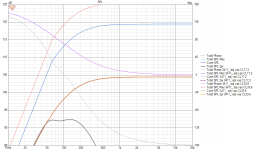I have the phl 2460 in the PE 0.56cu ft box. No stuffing or anything, I just want to see how bad it can be.
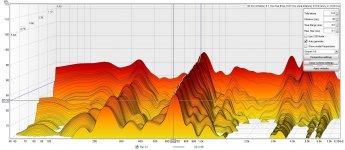
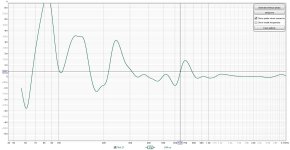
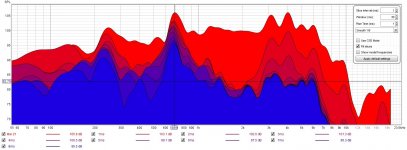
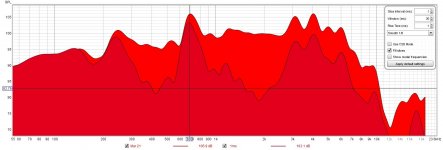
I expected some humps based on the distortion plots provided by the manufacturer. Well, here they are!
Even with the humps, it sounds very nice to my ears. I can see why high-hats are sounding so good since 300hz and 1khz have really good decays.
Hopefully either some stuffing, a new box, or maybe a perforated sheet targeted at those resonant freqs. will clean things up a bit. I'll measure with stuffing and new boxes next round.




I expected some humps based on the distortion plots provided by the manufacturer. Well, here they are!
Even with the humps, it sounds very nice to my ears. I can see why high-hats are sounding so good since 300hz and 1khz have really good decays.
Hopefully either some stuffing, a new box, or maybe a perforated sheet targeted at those resonant freqs. will clean things up a bit. I'll measure with stuffing and new boxes next round.
Are you going to compare generalized stuffing with your idea of more targeted absorption via perforated sheets and foam at a specified distance?
If you get the opportunity it would be great if you could measure the coax tweeter and woofer separately at a few different angles. Every similar sized coax seems to have a consistent 3 to 4K dip, I wonder if PHL's phase shield may be to target this.A phl 970 was added just to check out the 5" driver and try PHL's take on a coax. I also have a sb coax that costs 1/3 this one and will do a comparison.
Yes. I will compare a few diff spacings and materials. I am curious about using multiple metal sheets. The nomogram from the papers below shows how to link the target freq, to the distance from the back wall, and the size of the throat of the hole in the metal.Are you going to compare generalized stuffing with your idea of more targeted absorption via perforated sheets and foam at a specified distance?
more info:
https://www.marcospecialtysteel.com.../01/Perforated-Handbook-for-designers-min.pdf
http://www.iperf.org has a paper called The_Acoustical_Uses_for_Perforated_Metals_Handbook.pdf. It used to be available and is now behind some login. There is a web version that is still available without friction. All of the good info is in that doc.
I made a test box for the phl 970nd while watching a movie. There is some melamine and acousta-stuf in the box. Since I was measuring late I did not calibrate the spl's but these lazy measurements should be fine for looking at the tweeter.If you get the opportunity it would be great if you could measure the coax tweeter and woofer separately at a few different angles. Every similar sized coax seems to have a consistent 3 to 4K dip, I wonder if PHL's phase shield may be to target this.
not the best photo of the test baffle but it was the funniest.
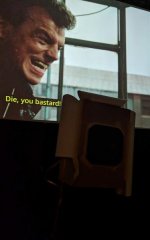
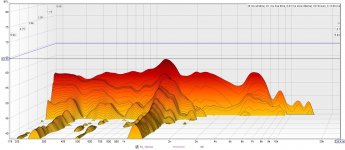
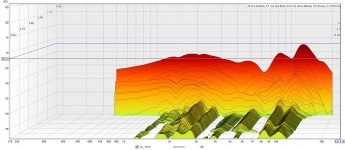

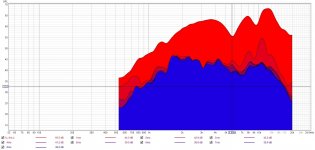
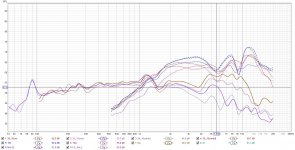
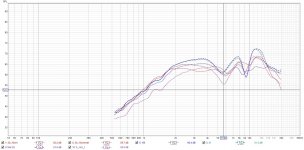
measurements were done by just moving the mic around and pointing at the center. I'd say 0-45 degrees. The tweeter is flatter 2-4khz off-axis more than it is on-axis. The mic was 0.6 meters away or so. I did a few 0 degrees hor. measurements moving the mic up and down a bit to look for changes.
The 970nd is not flush-mounted and is 12mm thick. I wonder what will clean up when it is flush?
Let me know if there is something else you want to see. When I take a crack at an XO I will measure further back and use a laser to keep the distances the same.
No problem.Thanks for making the measurements, the woofer looks OK but the tweeter looks messy.
My newbie hope is that it will clean up a little more with a proper baffle.
The dips do match a 1/4 wl that overlaps with where it is sticking out.
Every similar sized coax seems to have a consistent 3 to 4K dip,
Here is what I got out of the 5" SBA coax:
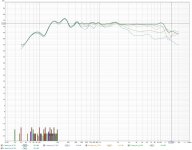
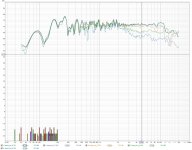
Is this what you mean as a dip? The loss in power as you go off-axis?
Last edited:
It could well do, your SB results are much nicer, coaxes almost never measure great but people report that they sound good 🙂My newbie hope is that it will clean up a little more with a proper baffle.
Not really that is just the directivity of the driverIs this what you mean as a dip? The loss in power as you go off-axis?
I have circled dips in red, anything that goes through all the curves is probably driver related but when they change between angles it is something else.
They are small in this case and most are gone with smoothing.
Ah, those bumps. I think a small coax is an imperfect horn (unless it is the $$$ seas coax). All the freq. that are shorter than the cone will get chewed up or canceled. I was using a 44mm edge radius so any humps are from the driver, not the baffle.have circled dips in red, anything that goes through all the curves is probably driver related but when they change between angles it is something else.
They are small in this case and most are gone with smoothing.
I am ok with a mess above 5khz. My aim is a nice 2-5khz. So far, I am getting that from the phl coax.- just a bit of mess elsewhere.
I had a tricky time doing the eq for the sb coax. The filters had to be tested on each axis since there was such a change between each one. The end result was the average of 0-90 was fairly even.
...
a little update...
I let VCAD's optimizer take a crack at a couple XO's for the PHL 970nd.
There is no baffle step correction since this XO was made with a close measurement. I don't want to put too much into it until it has a proper baffle but I do want to give a listen.
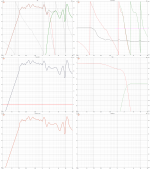
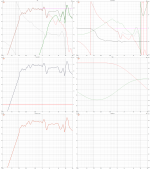 .
.I will take some measurements at 1m and eq at that position next. Also, some more stuffing should be put in the box to try and clean up 1.5khz.
It is not easy to get it right, the SEAS C18EN looks good and the only one of theirs's that measures pretty well. It compares pretty well with KEF but at $500 ish US it is not cheap but not outrageous for a magnesium mid cone and a tweeter thrown in 🙂Ah, those bumps. I think a small coax is an imperfect horn (unless it is the $$$ seas coax). All the freq. that are shorter than the cone will get chewed up or canceled. I was using a 44mm edge radius so any humps are from the driver, not the baffle.
An odd frequency range to choose a coax.I am ok with a mess above 5khz. My aim is a nice 2-5khz. So far, I am getting that from the phl coax.- just a bit of mess elsewhere.
Stop tearing apart my reasons for buying something I don't need! /sAn odd frequency range to choose a coax.
At some point this will be for a "no null" reference and a HT speaker to sit behind the couch.
...
phl 2460 round 2.... the second box.
Got the driver in the larger 12"x12"x12" PE box with a foam baffle (round 1 box is below it in the pic.). There is 2" of melamine 4" from the back wall and that area is filled with acousta-stuf.
Since it was late I did not calibrate the mic. The measurements were taken 5cm from the driver. The boxes are a bit low on the floor and I needed to point the mic down. Future measurements will be up higher.
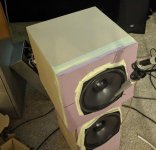
the two PHL 2460s in two different PE boxes.
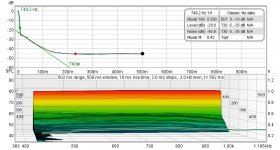
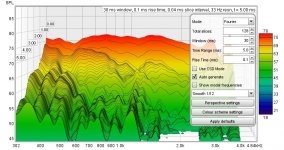
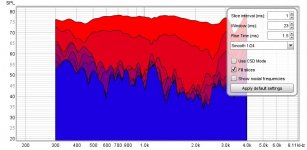

Ok, this is the other driver. Now I want to swap them to be sure the 1st one can clean up like this.
It does look like some of the decay is slowed by the amount of material in the box if you compare it to the 1st measurement. Next up is changing up the insides and seeing what can be seen. This might be too much stuffing.
Been listening in mono to the phl 2460 without a tweeter for a week and decided to go to level 2 while I decide on parts.
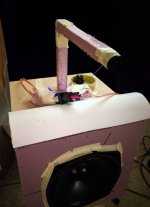
The sb12 tweeter is on some foam scrap. The tweeter is sticking out past the baffle. My ears like it so far. There is just a simple XO in place and the drivers time/level matched. I will do a 1m rough polar this week.
A ripple tank 2d sim show that a min-baff. can clean up the off-axis decay at the cost of on-axis interference. On a min-baff., I think extending the baffle depth also helps the off-axis decay. The next version will use a 12-16" length from the back of the tweeter.
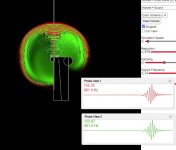
This was something I've always wanted to try. I think it would be neat to A/B with a version on a larger foam baffle.

The sb12 tweeter is on some foam scrap. The tweeter is sticking out past the baffle. My ears like it so far. There is just a simple XO in place and the drivers time/level matched. I will do a 1m rough polar this week.
A ripple tank 2d sim show that a min-baff. can clean up the off-axis decay at the cost of on-axis interference. On a min-baff., I think extending the baffle depth also helps the off-axis decay. The next version will use a 12-16" length from the back of the tweeter.

This was something I've always wanted to try. I think it would be neat to A/B with a version on a larger foam baffle.
did a baffle sim on a few tweeters for a min-baffle.
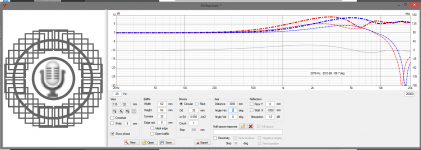
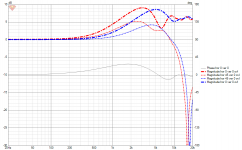
It seems like I have to have an edge radius if I want to use a 100mm tweeter. I don't need one with a 60mm or smaller tweeter. This is basic sim with just the sd and baffle shape. The thick lines are 0deg, thin are 45 deg. Red is the bliesma t34b and blue is the accuton c30.
If I put the sb14 with the t34b and c30-6-358 it looks like this:
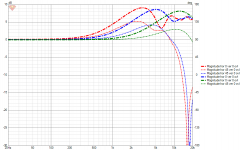
I can see why I needed a shelf to bring down 10khz with the sb14.
Now I am on the hunt for sub 60mm OD tweeters. I am open to suggestions. A sub 1khz FS is preferred.


It seems like I have to have an edge radius if I want to use a 100mm tweeter. I don't need one with a 60mm or smaller tweeter. This is basic sim with just the sd and baffle shape. The thick lines are 0deg, thin are 45 deg. Red is the bliesma t34b and blue is the accuton c30.
If I put the sb14 with the t34b and c30-6-358 it looks like this:

I can see why I needed a shelf to bring down 10khz with the sb14.
Now I am on the hunt for sub 60mm OD tweeters. I am open to suggestions. A sub 1khz FS is preferred.
Attachments
ScanSpeak D3004 series has several 62 mm flange-size tweeters, both textile and beryllium. For example: https://www.scan-speak.dk/datasheet/pdf/d3004-602010.pdf
ooohh. Nice. Thanks.ScanSpeak D3004 series has several 62 mm flange-size tweeters, both textile and beryllium. For example: https://www.scan-speak.dk/datasheet/pdf/d3004-602010.pdf
Crazy low fs for the size.
Looks like SS is going to update these tweeters this year according to the site.
...
I have some real data for the sb 14 with no baffle. This time the levels were calibrated but I did do it late at night so the levels were low. Still, some 30db of decay can be seen. A laser distance meter was used and the mic was moved for each angle. I had more angles but messed up the REW session. All the measurements were taken at 1 meter.

orange line: sb14 with no eq, green: with a -14 db shelf filter. This is all it really needs to be flat.
The orange line looks darn close to the predicted response. VCAD rules!

The decay is only clean -10db but it drops like a lead curtain. Notice the shape of the cut off 2.1khz on the left.
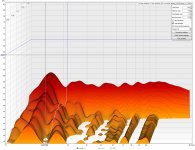
1-2khz is a hot mess with the resonance. The XO is at 2.4khz.
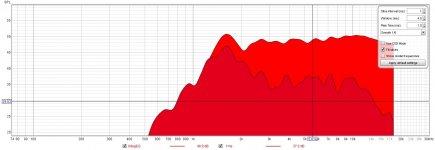
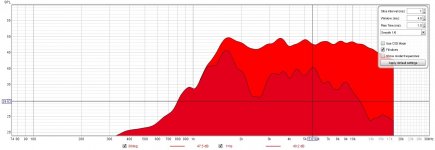
Decay at 1m 0deg and 30deg-ish. I guess the degrees but not the distance.
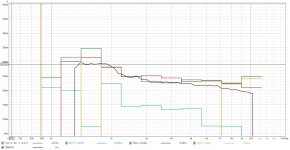
The blue EDT is how long it takes to drop -10db. I am happy with how this looks!
The sb14 is a tease. I have heard all kinds of new things on familiar songs but it for sure lacks in some ways. (SB Acoustic please make a Be sb14.)
I found small tweeters on TLHP and PE. Only one is smaller than the sb14 but needs an XO of 4khz. Everything else is larger.
From my sims, any tweeter smaller than 30mm will not need an edge radius. A 40mm driver needs a 20mm edge radius and a 60mm tweeter needs a 40mm edge.... what I wonder about is what each baffle size will do to the decay time. Whatever combo can do like -20db in decay in under .3ms I think is the new tweeter goal (if that is even possible). An FS below 1khz is also ideal.
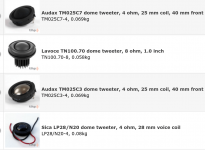
I might get a couple of these. Still deciding on what to do.
| f3 31.7 Hz f6 25.9 Hz f10 20.3 Hz Zmin 6.4 Ohm @ 277 Hz Zmax 110.5 Ohm @ 64.4 Hz GDmax 9.5 ms @ 32.2 Hz XmaxC 1.4 mm @ 18.3 Hz Pmax 5 VA @ 5 Hz ------------------------------------------------------------- DRIVER: PHL 5510MNdS, 1 pcs in series n0 17.66 % Reference efficiency SPL 104.6 dB/W Sensitivity USPL 105.6 dB/2.83 Sensitivity EBP 88.2 Efficiency bandwidth product Dd 33.7 cm Effective diameter of driver Vd 802.8 cm^3 Maximum linear volume of displacement Cas 2.07E-6 m^5/N Acoustic equivalent of Cms Mas 1.34E1 kg/m^4 Acoustic equivalent of Mms+Mme Ras 3.79E2 Ns/m^5 Acoustic equivalent of Rms Rae 7.62E3 Ns/m^5 Acoustic equivalent of Re+Rg ------------------------------------------------------------- BOX REAR 1: Vb=82.0 l, Ql=100.0 Fb 64.5 Hz System resonance frequency Cab 5.8E-7 m^5/N Acoustic compliance of air in enclosure Rab 4.67E1 Ns/m^5 Acoustic resistance due to absorption Ral 4.25E5 Ns/m^5 Acoustic resistance due to leakage Qtc 0.68 Total Q factor | f3 30 Hz f6 24.1 Hz f10 18.9 Hz Zmin 5.7 Ohm @ 5 Hz Zmax 141.5 Ohm @ 56.6 Hz GDmax 9.4 ms @ 29.5 Hz XmaxC 4.4 mm @ 5 Hz Pmax 30.6 VA @ 5 Hz ------------------------------------------------------------- DRIVER: PHL 4021-8, 1 pcs in series n0 0.81 % Reference efficiency SPL 91.2 dB/W Sensitivity USPL 92.8 dB/2.83 Sensitivity EBP 97.2 Efficiency bandwidth product Dd 26.2 cm Effective diameter of driver Vd 404.3 cm^3 Maximum linear volume of displacement Cas 4.94E-7 m^5/N Acoustic equivalent of Cms Mas 4.23E1 kg/m^4 Acoustic equivalent of Mms+Mme Ras 8.61E2 Ns/m^5 Acoustic equivalent of Rms Rae 2.63E4 Ns/m^5 Acoustic equivalent of Re+Rg ------------------------------------------------------------- BOX REAR 1: Vb=42.0 l, Ql=100.0 Fb 56.8 Hz System resonance frequency Cab 2.97E-7 m^5/N Acoustic compliance of air in enclosure Rab 1.04E2 Ns/m^5 Acoustic resistance due to absorption Ral 9.43E5 Ns/m^5 Acoustic resistance due to leakage Qtc 0.55 Total Q factor |
| f3 35.1 Hz f6 27.5 Hz f10 20.9 Hz Zmin 5.6 Ohm @ 538.2 Hz Zmax 123.6 Ohm @ 78.9 Hz GDmax 7.4 ms @ 20.6 Hz XmaxC 5 mm @ 5 Hz Pmax 39.3 VA @ 5 Hz ------------------------------------------------------------- DRIVER: phl audio 3411_ adj vas, 1 pcs in series n0 2.78 % Reference efficiency SPL 96.6 dB/W Sensitivity USPL 98.1 dB/2.83 Sensitivity EBP 195.8 Efficiency bandwidth product Dd 21.3 cm Effective diameter of driver Vd 284.8 cm^3 Maximum linear volume of displacement Cas 2.53E-7 m^5/N Acoustic equivalent of Cms Mas 4.89E1 kg/m^4 Acoustic equivalent of Mms+Mme Ras 2.45E3 Ns/m^5 Acoustic equivalent of Rms Rae 5.92E4 Ns/m^5 Acoustic equivalent of Re+Rg ------------------------------------------------------------- BOX REAR 1: Vb=17.2 l, Ql=100.0 Fb 79.3 Hz System resonance frequency Cab 1.22E-7 m^5/N Acoustic compliance of air in enclosure Rab 1.81E2 Ns/m^5 Acoustic resistance due to absorption Ral 1.65E6 Ns/m^5 Acoustic resistance due to leakage Qtc 0.40 Total Q fact | f3 34.1 Hz f6 27.1 Hz f10 20.6 Hz Zmin 5.4 Ohm @ 439.7 Hz Zmax 86.4 Ohm @ 67.3 Hz GDmax 7.8 ms @ 13.5 Hz XmaxC 13.9 mm @ 5 Hz Pmax 293.6 VA @ 5 Hz ------------------------------------------------------------- DRIVER: phl audio 4310Ndu, 1 pcs in series n0 1.56 % Reference efficiency SPL 94.1 dB/W Sensitivity USPL 95.8 dB/2.83 Sensitivity EBP 153.6 Efficiency bandwidth product Dd 25.9 cm Effective diameter of driver Vd 527.0 cm^3 Maximum linear volume of displacement Cas 3.89E-7 m^5/N Acoustic equivalent of Cms Mas 3.35E1 kg/m^4 Acoustic equivalent of Mms+Mme Ras 1.98E3 Ns/m^5 Acoustic equivalent of Rms Rae 3.23E4 Ns/m^5 Acoustic equivalent of Re+Rg ------------------------------------------------------------- BOX REAR 1: Vb=42.0 l, Ql=100.0 Fb 67.0 Hz System resonance frequency Cab 2.97E-7 m^5/N Acoustic compliance of air in enclosure Rab 8.78E1 Ns/m^5 Acoustic resistance due to absorption Ral 7.99E5 Ns/m^5 Acoustic resistance due to leakage Qtc 0.41 Total Q factor |
The debate is I like the idea of (2) 10" sealed on each side for the width and height but these drivers will have to run at 105db to play 93db of bass- it is the most inefficient solution. Any parameters to look out for? Is it all a matter of just picking the one that does not break the Xmax at the SPL I want?
I get the EBP and a couple of other parameters. The Mas, Ras, Rae I have no clue and will google later.
Will do. Thanks!If you want to try a small baffle that has an edge radius, I can help fabricate that. It is not difficult with my equipment. email me...
j.
I was thinking about this prob. again and maybe just sticking the sb14 in a couple of diff.. sized baffles will do it.
Did a late-night experiment with baffles. I had some foam scrap and used a 60mmx60mm baffle and a 195mmx170mm baffle on the existing tweeter. The measurements were done less than 1m and used a small window. The XO at 2.4khz is in place for the measurements. The filters for the tweeter were made for no baffle. In the future, I'll make filters for each baffle to see the decay that way.
First a sim of the baffles:
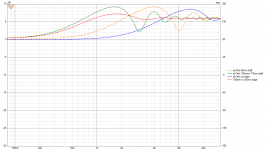
hifijim just made a foam baffle with nice 50mm edge radius and he is bringing that over next week.
Note with no baffle, the s14 has diffraction going all the way to 10hz. It is just clean in the area of the XO. This diffraction at 10khz does show up in real measurements.
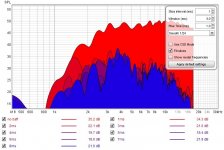
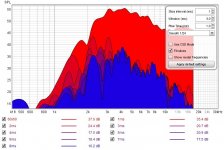
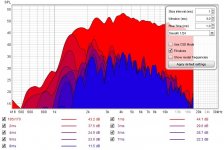
It looks like 1khz diffraction is far worse than 10khz diffraction- even with the XO in place.
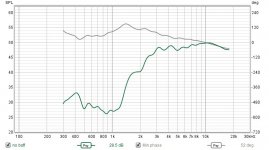
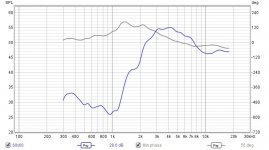
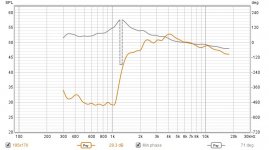
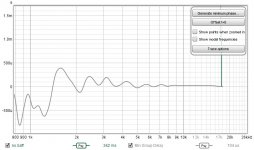
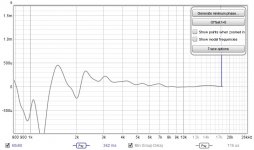

I can instantly hear a difference with a 60mm baffle at 3m away. Did I do a blind test? no, but it does have more power at a spot where ears are extremely sensitive. I do wonder if I could tell a difference with some eq for each baffle shape.
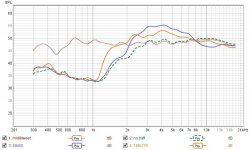
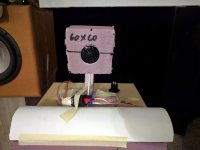
Some phl2460 (WIP) measurements + the no baffle tweeter. Same spot as above.
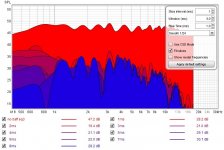
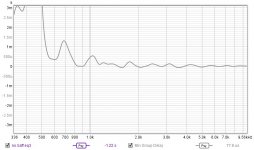

First a sim of the baffles:

hifijim just made a foam baffle with nice 50mm edge radius and he is bringing that over next week.
Note with no baffle, the s14 has diffraction going all the way to 10hz. It is just clean in the area of the XO. This diffraction at 10khz does show up in real measurements.



It looks like 1khz diffraction is far worse than 10khz diffraction- even with the XO in place.






I can instantly hear a difference with a 60mm baffle at 3m away. Did I do a blind test? no, but it does have more power at a spot where ears are extremely sensitive. I do wonder if I could tell a difference with some eq for each baffle shape.


Some phl2460 (WIP) measurements + the no baffle tweeter. Same spot as above.



Last edited:
An A/B mono setup is in the works. Now that I have hifijim's sweet baffle I can add that to the other side of the room.
Please note hifijim's space laser precision vs my rat chewed cuts:
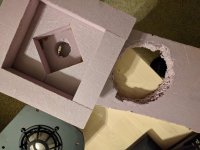
I am embarrassed that I once suggested to him how to cut foam in another thread.
Thanks again for the baffle, hifijim!!!
...
Last week I got the Visaton DSM50 and AL130M in from mouser after 5 weeks of waiting. Better than the 8 week estimate!
The dsm50 reminds me of a 1/2 scale yamaha ja0801. I hoped that it would speed up the 2khz area and it did! Having a clear 2-3khz really opened up the sound. It is not without flaws, it suffers from baffle diffraction if the dsm50 makes 1khz. I am still working on the XO to find the right spot.
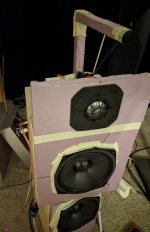
There is a very small change in the GD with the dsm50 in the mix:
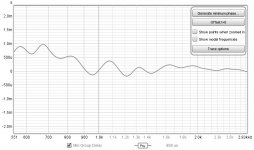
The sb14st has a crappy 2-3khz so replacing it is also an option. I ordered five tweeters from TLHP that are 30-43mm in width.
There is a sixth tweeter that is not available yet- the Eminence SD28. The measurements look great:
https://audioxpress.com/article/test-bench-eminence-sd28-soft-dome-tweeter
I think between 6 tweeters something should stand out.
It was reassuring to find a post where a guy was using the Sica LP28 to replace the tweeter on a B&W speaker:
http://forum-hifi.fr/thread-7614-page-4.html
If a 30-40mm size is good enough for B&W then I should be on the right path.
Please note hifijim's space laser precision vs my rat chewed cuts:

I am embarrassed that I once suggested to him how to cut foam in another thread.
Thanks again for the baffle, hifijim!!!
...
Last week I got the Visaton DSM50 and AL130M in from mouser after 5 weeks of waiting. Better than the 8 week estimate!
The dsm50 reminds me of a 1/2 scale yamaha ja0801. I hoped that it would speed up the 2khz area and it did! Having a clear 2-3khz really opened up the sound. It is not without flaws, it suffers from baffle diffraction if the dsm50 makes 1khz. I am still working on the XO to find the right spot.

There is a very small change in the GD with the dsm50 in the mix:

The sb14st has a crappy 2-3khz so replacing it is also an option. I ordered five tweeters from TLHP that are 30-43mm in width.
There is a sixth tweeter that is not available yet- the Eminence SD28. The measurements look great:
https://audioxpress.com/article/test-bench-eminence-sd28-soft-dome-tweeter
I think between 6 tweeters something should stand out.
It was reassuring to find a post where a guy was using the Sica LP28 to replace the tweeter on a B&W speaker:
http://forum-hifi.fr/thread-7614-page-4.html
If a 30-40mm size is good enough for B&W then I should be on the right path.
I listened to one of the mock-ups when I delivered the foam baffle to Headshake. We listened to the PHL 8" driver and the SB14 tweeter, in mono... see post #111. It was surprising, and eye-opening, to hear the naked SB14 tweeter just suspended in space. His experimental setup allows him to switch out tweeter baffles fairly quickly, and it is very easy to hear the difference between no baffle, small baffle, low-diffraction baffle, and large baffle. I found it very interesting.
J.
J.
Thanks again for the help with the baffle and for lending your ears.I listened to one of the mock-ups when I delivered the foam baffle to Headshake. We listened to the PHL 8" driver and the SB14 tweeter, in mono... see post #111. It was surprising, and eye-opening, to hear the naked SB14 tweeter just suspended in space. His experimental setup allows him to switch out tweeter baffles fairly quickly, and it is very easy to hear the difference between no baffle, small baffle, low-diffraction baffle, and large baffle. I found it very interesting.
J.
..
The tiny tweeters are in from TLHP. Did a run through dats 3:
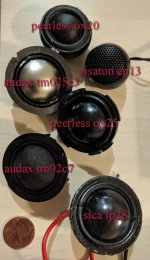
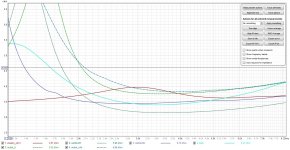
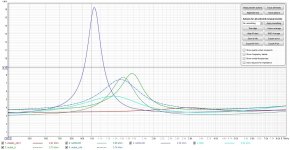
No bumps where they don't belong.... so far so good! The peerless ox20 is the smallest of the group and has the lowest fs. It also has the flattest 2-5khz impedance.
Tonight I'll be taping these to sticks and measuring with REW.
- Home
- Loudspeakers
- Multi-Way
- Headshake's far field 3way
